Learn how to open those coconuts! | ¡Aprende a abrir esos cocos!

¡Hola amigos! He vuelto con los siguientes pasos en el proceso de abrir cocos, en el post anterior les había contado mi método para pelar un coco desde el principio. En este les enseñare a sacar el agua, abrirlos y extraer la pulpa, así que ¡manos a la obra!
Hi, everybody! I'm back with the next steps in the process of opening coconuts, in the previous post I had told you my method for peeling a coconut from the beginning. In this one I'll show you how to take out the water, open them and extract the pulp, so let's get to work!
Bien, ya tenemos nuestro coco pelado, el próximo paso es obtener su agua, para esto yo utilizo un cuchillo puntiagudo, una piedra o martillo y un destornillador.
Now, we have our coconut, the next step is to get its water, for this I use a sharp knife, a stone or hammer and a screwdriver.
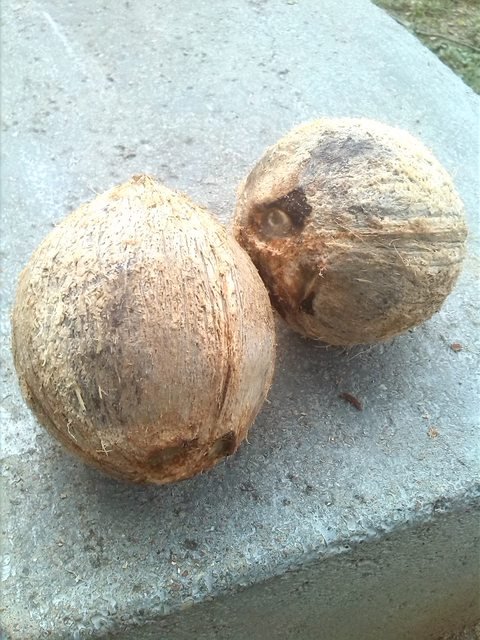
Cocos pelados de la vez anterior | Peeled coconuts from last time
Lo primero es abrir el hueco principal, fíjate que de los 3 huequitos hay uno solo que es mas redondo, cortas allí con el cuchillo puntiagudo, si el coco está en perfecto estado hará un sonido como el de abrir un frasco o un refresco (soda).
The first thing to do is to open the main hole, notice that out of the 3 little holes there is only one that is rounder, cut there with the sharp knife, if the coconut is in perfect condition it will make a sound like opening a bottle or a soda.
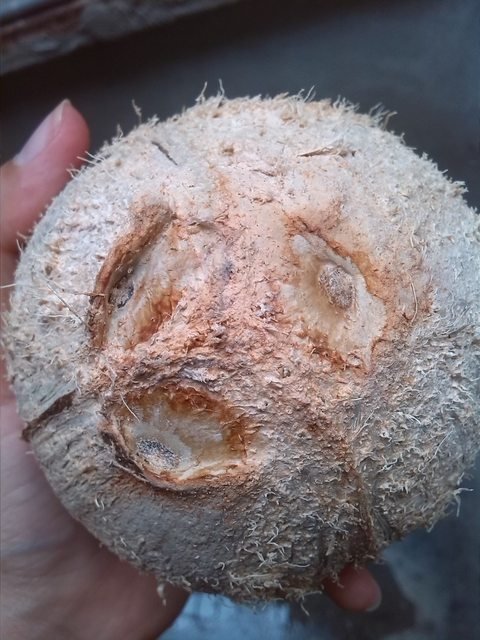
Hoyo principal a la derecha | Main hole to the right
Una de las formas para obtener el agua es introducir un pitillo (pajilla) solo un poco para que el agua salga, la otra forma y la más común es, luego de abrir el hueco principal, se abre uno de los huequitos secundarios con un destornillador, de esta manera el coco tendrá una entrada de aire lo que permitirá la salida del liquido. Para hacer esto es recomendable apoyar el coco en un paño o tabla de madera, colocas el destornillador en el hueco y lo golpeas con un martillo o piedra, si otra persona de ayuda a sostener el coco es muchísimo mejor.
One of the ways to obtain the water is to introduce a straw just a little bit so that the water comes out, the other way and the most common is, after opening the main hole, one of the secondary holes is opened with a screwdriver, this way the coconut will have an air intake which will allow the liquid to come out. To do this it is advisable to support the coconut on a cloth or wooden board, place the screwdriver in the hole and hit it with a hammer or stone, if another person can help you hold the coconut is much better.
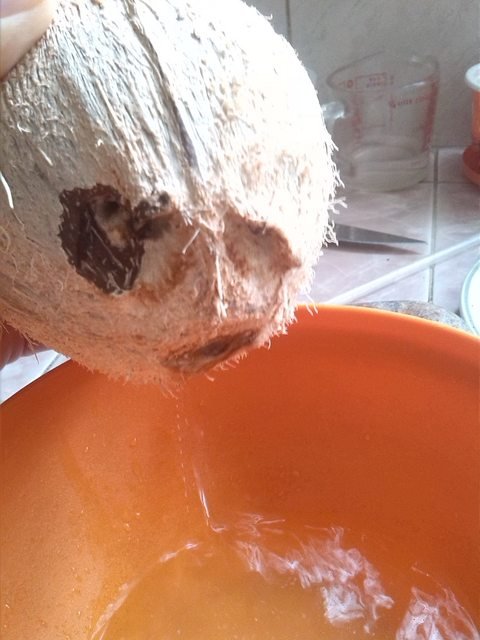
Aquí pueden ver el agua saliendo del coco con los agujeros perforados | Here you can see the water coming out of the coconut with both holes punctured
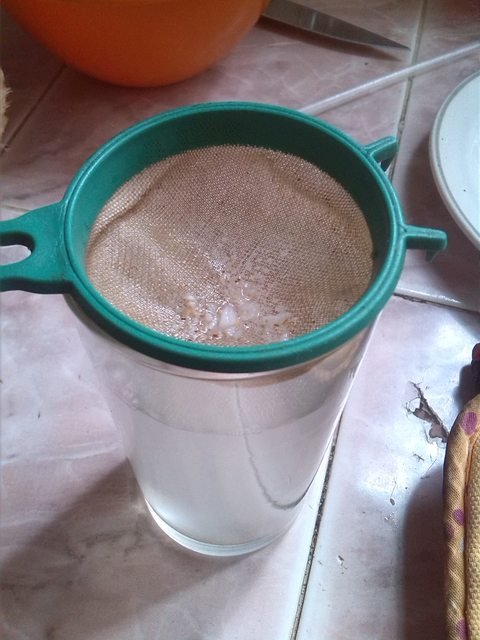
puede que quieras colar el agua de los cocos. | you might want to strain the water from the coconuts.
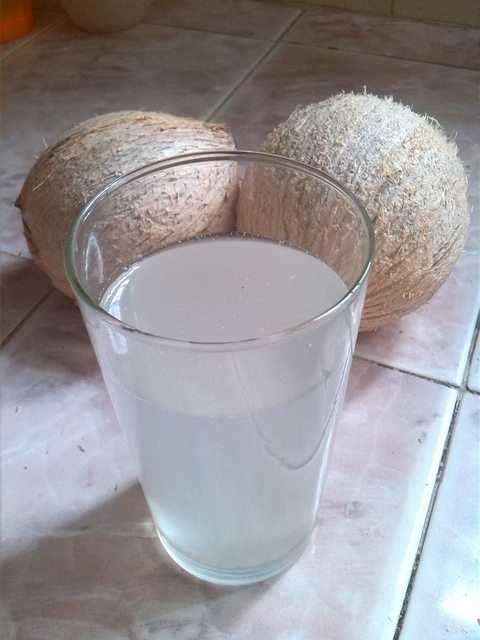

El último paso de este proceso es abrir el coco para extraer su pulpa, para ello probé con dos formas que me parecieron igual de efectivas.
La primera es colocar el coco dentro del horno (precalentado) junto con medio vaso de agua. Yo puse el coco dentro de un molde de torta para no ensuciar el horno y el vaso que usé fue de aluminio, asegúrense que sea resistente al calor. Dejan el coco unos 15 o 20 min a temperatura media y pasado ese tiempo lo sacan, tomen sus precauciones que estará caliente.
The last step of this process is to open the coconut to extract its pulp, for which I tried two forms that I found equally effective.
The first one is to put the coconut inside the oven (preheated) along with half a glass of water. I put the coconut inside a cake pan so I wouldn't mess up the oven and the glass I used was aluminum, so make sure it's heat resistant. Leave the coconut for 15 or 20 minutes at medium temperature and after that time take it out, take your precautions as it will be hot.
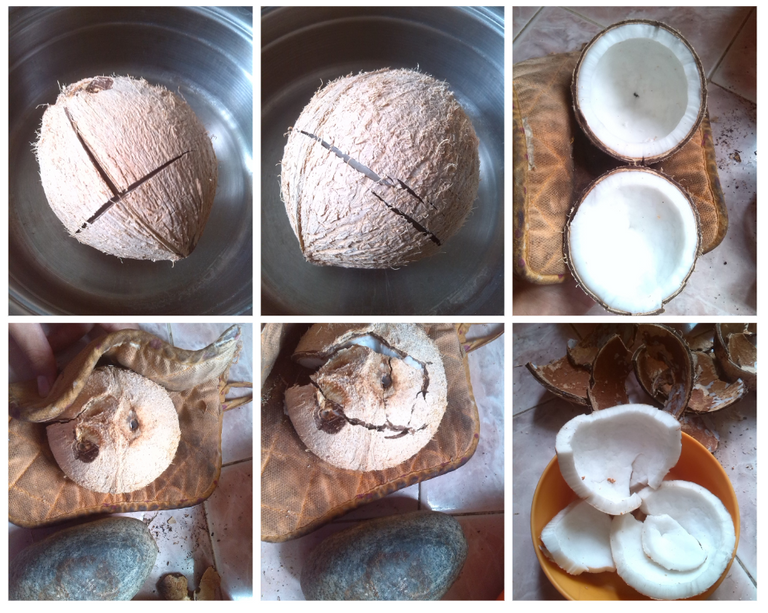
La segunda forma consiste en colocar el coco directo en la hornilla de la cocina y dejarlo que se queme un poco por todas partes. Al igual que el método anterior se agrietará un poco la cáscara.
Con cualquiera de estas dos técnicas se abre el coco de la misma forma, lo tomas con un paño para no lastimarte y lo golpeas con un martillo o una piedra girándolo cada tanto. No te desesperes si con los primeros golpes no se abre, continua haciéndolo y eventualmente se romperá por completo. Finalmente introduce un cuchillo por el borde de la cáscara y haz palanca, la pulpa se irá desprendiendo con facilidad.
The second way is to place the coconut directly on the stove and let it burn a little bit everywhere. Like the previous method, the shell will crack a little.
With either of these two techniques you can open the coconut in the same way, take it with a cloth so you don't get hurt and hit it with a hammer or a stone turning it from time to time. Don't despair if the first few blows don't open it, keep doing it and eventually it will break completely. Finally insert a knife through the edge of the shell and pry it open, the pulp will come off easily.
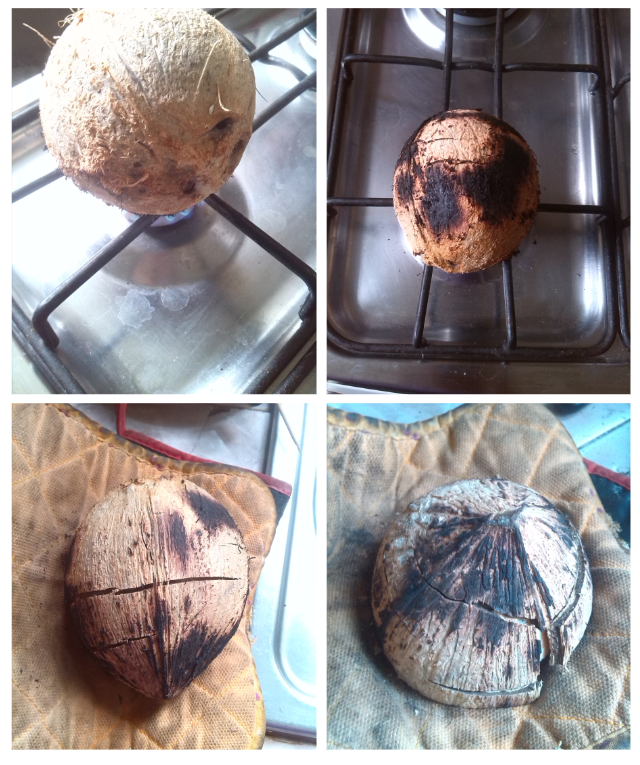
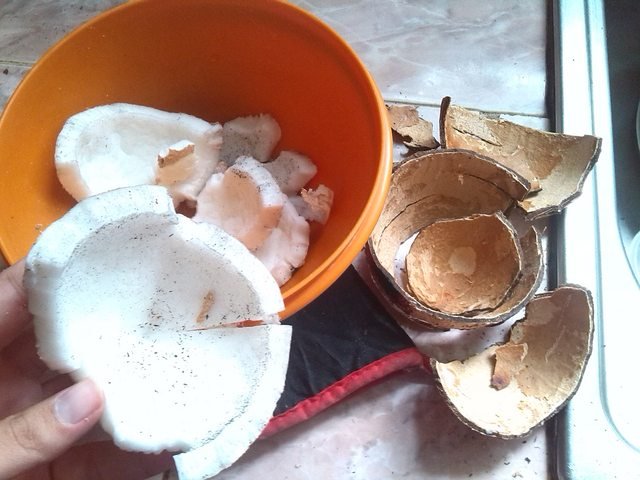
Después puedes enjuagarlo y quedará listo | Then you can rinse it and it'll be ready!
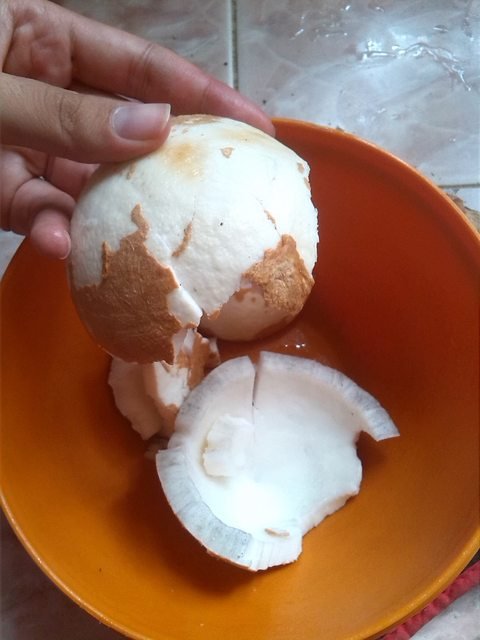
Hay quienes le quitan esa delgada cascara con un pelador, pero yo se la dejo. ademas este quedó practicamente sin ella. | There are those who remove that thin shell with a peeler, but I leave it. Besides, this one came out practically without it.
Esto ha sido todo, por ahora, quizás lo vean fácil pero lleva bastante trabajo, en especial porque cuando lo hago no es con uno solo, sino con 4 o hasta 7 cocos de una sola vez, sin embargo es bastante gratificante disfrutar de todas las cosas que se pueden preparar con ellos, las cuales les mostraré próximamente. ¡Hasta pronto!
This has been all, by now, perhaps you see it easy but it takes a lot of work, especially because when I do it is not with one, but with 4 or even 7 coconuts at once, however it is quite rewarding to enjoy all the things that can be prepared with them, which I will show you soon. Bye!


Gracias por leerme. | Thanks for reading.
Todas las fotos son de mi autoría. | All photos are my own.
That's really interesting! I always used a sharp object to poke the little eye holes to drain the liquid then I would honestly use a hammer to crack it lol it was a very messy process! I think cooking it in the oven would work pretty well. Does the coconut meat spoil faster when it is cooked though? That would be my only concern!
i used to do it that way too! i always used the straw method to get the water and then i smashed it with a rock! it was this year i found out the coconut heating thing, though my grandma always said that you could easily break it putting it on the stovetop.
wether you heat it in the oven or in the stove it really won't cook, it just gets hot enough for the shell to come off, but it does give it a nice toasted smell, and even a better taste. i think it'll last the same this way than raw.
thanks for passing by!
Congratulations @fanyokami! You have completed the following achievement on the Hive blockchain and have been rewarded with new badge(s) :
You can view your badges on your board And compare to others on the Ranking
If you no longer want to receive notifications, reply to this comment with the word
STOPTo support your work, I also upvoted your post!
Do not miss the last post from @hivebuzz:
Support the HiveBuzz project. Vote for our proposal!
muchas gracias 😉
A su orden 😘
I've only ever seen them cracked open with a machete. I like this way better. Less dangerous for my fingers.
It works well that way too! but i like when the coconut comes off the shell almost whole, it's better when you need to grate it for some recipe. always be careful!